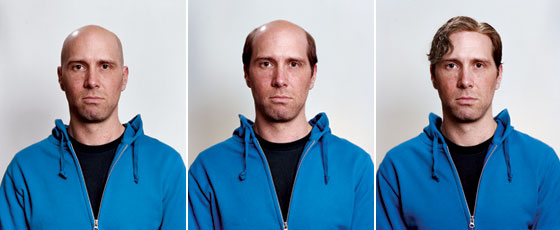
I started balding noticeably at 27, and I’ve been shaving my head ever since. That was back in the nineties, a halcyon era when head-shaving was a thrilling act of generational defiance. These days, however, unapologetic cue balls are everywhere.
This only started to bother me in the last few years, when a small pileup of illness and injuries left me feeling far less confident in my appearance above and below the neck. Last fall, when I decided to research hairpieces, I told people it was out of boredom and a playful need to rediscover my individuality—it wasn’t as if I’d be trying to fool anyone. But I had a hunch it might make me look better, too.
If you’re just starting to lose your hair, you can try Propecia or laser therapy. But when you’re as far along as I am, not even transplants are an option. That left me with one choice: the best toupee I could find. They’re not called toupees anymore—they’re “hair systems,” which generally involve regular visits to a “hair restoration” salon. The most famous purveyor is hair-restoration monolith Hair Club for Men. With proper care, a Hair Club piece—treated human hair affixed to a near-invisible mesh base—can last up to three years. Ick. The price also made my flesh crawl: $2,000 at a minimum. I checked out a competitor, Virtual Reality, official technology (and yes, this made it seem cooler) of Hollywood hair and makeup union Local 706. The difference didn’t seem dramatic: Virtual Reality’s base, the “Dermalens,” is impossible-to-see liquid polyurethane. The cost: $500 a month. But with Virtual Reality you can come and go as you please—the Dermalens is meant to be replaced each month, like a contact lens.
So I took the LIRR out to Valley Stream, home of the Natural Image salon. Chris Licursi, Natural Image’s spiky-haired owner—and, of course, client—owns the rights to Virtual Reality for the New York area; his latest salon opens this month on Lexington Avenue. For my new look, I wanted to emulate my shaggy-haired hero, tennis star Roger Federer. Because I wanted a longer style, I had to have something for the Virtual Reality hair to blend into, so I’d been growing out the hair on the sides of my head for months. (A friend later confessed that he thought my Bozo the Clown look was a reaction to a recent death in the family.) A technician matched my hair color to her samples—I was ecstatic to discover that I’m still a natural blond—painted my pate with surgical-grade glue, then pulled on the Dermalens as you would a bathing cap.
Was it really 2007? Staring back at me in the mirror was me, but me from five or even ten years ago. And I wasn’t the only one who thought so. “You look so much younger!” people exclaimed. “You look like a model!” The wife of one friend made disturbingly piercing eye contact. And the night before my grandmother’s 90th-birthday party, Grandma pulled me close and said, “I hope you wear that thing tomorrow. You look gorgeous!”
Other people just plain didn’t recognize me. When I ran into a friend, he froze, wondering if I was someone he’d slept with (I wasn’t). Soon, I started developing arrogant little gestures, like tossing my head to get my “hair” out of my eyes.
Not all reactions were positive. Without a bit of wet-look styling gel, my Federer appeared synthetic. My early overdependence on the stuff prompted my (non-bald) boyfriend to declare that I had “Hitler hair” and go on a sex strike. I wasn’t entirely surprised. When I first told him about my plan, he said he’d break up with me.
What would it be like to be single with this on? The system is almost undetectable—you can run your hands through it and even, I guess, yank on it in the heat of the moment. I like to think that “coming out” would be a dating litmus test. After all, we all end up disclosing something. Meanwhile, the boyfriend had his allies. Some friends, suspecting that my piece was an outgrowth of low self-esteem or pride or both, asked when the charade would end. (It’s just hair, for God’s sake! I’d think.) Bald friends were openly jealous: “I want my blond locks back, too,” wailed one. About the only person who remained unfazed was a black colleague, who matter-of-factly showed me the inner workings of her weave.
Maintenance wasn’t so easy; I had to become my own special-effects artist, removing bits of gunked-up glue. It occasionally itched, especially after the gym. And I had to give up steaming showers (hot water can break down the glue). But these were small sacrifices. The inventors of Virtual Reality gave their product a more apt name than perhaps they know. It’s not just that the hair is virtually real—it’s that wearing it makes reality virtual. With my Federer on, I lived in a world where people saw me, for the most part, as younger and handsomer than I am. It was amazingly tempting to believe them.
Which is why I decided the piece had to come off. It was okay to live in a fantasy as long as it didn’t mean I couldn’t hack reality. I was pleasantly surprised when Licursi & Co. removed the system and not just because my boyfriend called off the strike. I thought I looked good (for one thing, I hadn’t seen myself without wacky side hair for months), but it was also exciting to have changed my look yet again. Only a few weeks later, I was already daydreaming about a new style for summer. Maybe something yellow and spiky…